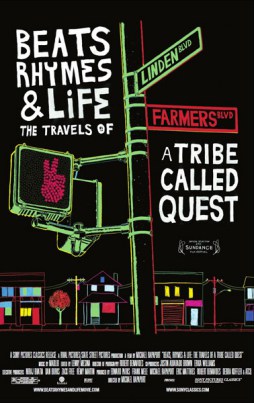rating:![]()
 When you’re looking to tell the story of a particular time and place it’s crucial to find the subjects at the centre of the story. How could you tell the story of the San Francisco acid craze without mentioning Leary, or including the Grateful Dead? In the same way, when documenting the growth of hip-hop in the ’90s, how could you ignore A Tribe Called Quest?
When you’re looking to tell the story of a particular time and place it’s crucial to find the subjects at the centre of the story. How could you tell the story of the San Francisco acid craze without mentioning Leary, or including the Grateful Dead? In the same way, when documenting the growth of hip-hop in the ’90s, how could you ignore A Tribe Called Quest?
In Beats, Rhymes & Life: The Travels of A Tribe Called Quest director Michael Rapaport documents the travails of the group, interviewing group members Q-Tip, Phife Dawg, DJ Ali Shaheed Muhammad and occasional member Jarobi White to tell their tale.
Interviews with other members of the hip-hop community also help illustrate just how influential the group was on the movement as a whole. Everyone from Pharrell Williams to Quest Love from the Roots, to Jive Records CEO Barry Weiss weigh in on the group’s rise and fall.
Mostly the film follows a structure that anyone who has ever seen VH1’s Behind The Music will recognize: obscurity, meteoric rise to fame, the good years, the bad years, the falling out.
However, that’s not where the film’s true quality lies, which is not to say that the story isn’t remarkable in itself. The group — which once received the largest cash advance ever for a recording contract — was incredibly influential in the hip-hop scene of the early ’90s. Living in the boroughs of New York afforded them the opportunity to work with people who would later become some of the biggest names in hip-hop.
Tribe’s frontman, Q-Tip, went to school with The Jungle Brothers and recorded with De La Soul; all of these groups who would become titans in the hip-hop world came up together, perfecting their craft in school yards and learning to deejay on their parents’ turntables with old jazz records.
A rich vein for any documentarian, to be sure, but the real triumph is in the way that Rapaport treats his subjects. Anyone could have made a story about 4 men who love each other, hate each other and then eventually make up, but only a sincere fan could have made a film that so perfectly captured the attitude of the group. Rapaport, a self-professed Tribe fanatic, clearly understands the spirit of the music.
Where Beats, Rhymes & Life really succeeds is in the mixture of the visuals with the soundtrack. It’s hard to go wrong with a palette as rich as Tribe’s discography. Over a decade of highly celebrated hip-hop is represented in the film, but it’s the way that the music is used to emphasize the visuals that really stands out. The film’s original animations merge seamlessly with the soundtrack and perfectly compliment the mood of the music. It’s clear that the mixing and sound editing was as important to Rapaport as the narrative or camera work.
The relevant question is, can a film made by a true fan that strives to capture the style and attitude of the group be as enjoyable to an indifferent observer? Of course, the film was made for fans of the group, but it is a great example of documentary filmmaking even if you have never heard a Tribe song. If you’re not a hip-hop fan then it might not be an instant favourite, but it’s a trip nonetheless.